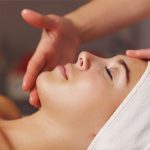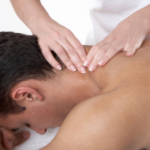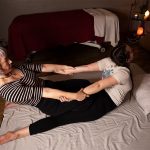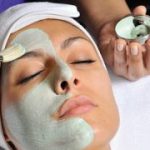By Michelle Vallet, May 28, 2014
We’ve all had days where we feel sad or blue. Nobody can be happy all of the time, and changes in mood, feelings of sadness sometimes, are perfectly normal. For some people, however, these feelings are more persistent and severe, interfering with everyday activities, lowering energy levels and interrupting sleep, for example. When these feelings begin to take over and noticeably change a person’s quality of life, seeing a mental health professional—and getting a depression diagnosis—can be the first step in getting the help they need.
For many who suffer, the solution most talked about is psychotherapy, where a person sees a trained mental health professional to talk (and perhaps be prescribed medication). But that approach doesn’t always work equally well for everyone. Now, people are also beginning to better understand how a combination of treatment options can be beneficial, and massage therapy is showing some promise in helping people better handle this condition.
Defining Depression
Perhaps one of the most difficult things about depression when talking about ways to help people who suffer is that arriving at a simple, straightforward definition of depression is next to impossible. Depression, unlike some other medical conditions, is seemingly fluid in nature, meaning the cause(s) and how symptoms manifest are often unique to the individual and can be a secondary complaint of another primary health condition, such as Alzheimer’s, for example, or other mental health issues. In other words, my depression isn’t your depression isn’t someone else’s depression.
That’s not to suggest, however, that there aren’t guidelines around diagnosing depression. Some people might think that depression is simply someone who is sad, but there’s a lot more to this condition than simply feeling down. Yes, sadness and unhappiness are definitely indicators of depression but, according to the Mayo Clinic, so are anger and irritability, loss of interest in activities that were once enjoyable, sleep disturbances, changes in appetite, cognitive problems, as well as physical pain, such as back pain or headaches.
There can also be different types of depression. For example, some women experience depression both during pregnancy and after delivery, while other people may be affected seasonally or have anxiety that accompanies the depression.
The Benefits of Massage
When you ask exactly how massage therapy works to benefit people with depression, the most accurate answer is “we don’t yet know.” But that’s not to say the benefitsaren’t real, and some, like Christopher Moyer, PhD and assistant professor of psychology at the University ofWisconsin–Stout, posit that massage therapy may work in similar ways as psychotherapy. “The size and effect of massage therapy on trait anxiety and depression is virtually the same as that routinely found in the research studies of psychotherapy for those same conditions,” he explains. “Typically, both take place in a private setting and are based on a ‘50-minute hour’ for the length of the session. Repeated sessions on a weekly schedule—orsimilar—would be a traditional or common pattern when the goal is long-term reduction of anxiety or depression.”
The other striking similarity is that both are dependent on an interpersonal relationship founded on trust. “Some psychotherapy researchers think that the existence of the trustingrelationship—sometimes referred to as the therapeutic bond, or as the working alliance—isthe most important component of psychotherapy’s effectiveness,” Moyer says. “And the same may also be true for massage therapy, though this is something that needs to be researched.”
Remember, too, that depression isn’t just mental health issues—some of the symptoms manifest physically, too. “Depression is considered a mental illness, but one feels it in the body as well, a sense of heaviness in the corporeal,” says Alice Sanvito, a massage therapist and owner of Massage-St. Louis in St. Louis, Missouri. “The physical experience of massage can change the physical sensation of heaviness to something lighter and can restore the feeling of living in one’s body again instead of being lost in one’s head.”
Moyer suggests something similar. “It’s tempting to say that yes, psychotherapy ought to have the greater potential to help because it ought to provide the person with skills and insight that reduce anxiety and depression, and that help the person avoid them in the future,” he explains. “And who is to say that massage therapy doesn’t do something similar to that? It’s possible that receiving massage therapy gives a person a kind of insight, in that it reeducates the person as to how their body and mind ought to feel when they are relaxed, healthy, less anxious and less depressed.”
There’s also the potential that—similar to chronic pain—some of the value of massage therapy for people with depression comes from interrupting the pattern of symptoms on a regular basis. “Each time one interrupts the pattern and experiences calm, it’s easier to remember what it’s like to live in a more normal state, gives one hope that it is possible,”Sanvito suggests.
The problem, however, is defining what regular means. Although research seems to suggest that more than one massage therapy session is more beneficial for people dealing with depression, beyond that, the information available gets fuzzier. “We do not yet have clear information on how many sessions of massage therapy, or in what pattern or frequency, are optimal or necessary,” Moyer explains. “Weekly sessions would be a good place to start. Then, depending on the response to treatment, that schedule could be adjusted as deemed necessary.
What You Need to Know
The constant in all of this is that there is no constant, meaning that massage therapists working with clients who suffer from depression need to educate themselves about the condition. In fact, Moyer believes all massage therapists should have some familiarity with both anxiety and depressive disorders because both are so common today.
Assess. Although an argument could be made that things are changing—you see more commercials dealing with mental health conditions, for example—the reality for many of these people is that mental health issues may carry a stigma. So, massage therapists can’tassume that clients who might be suffering from depression are going to offer this information up themselves. Some people, too, might not be aware they’re suffering from this disorder, so being aware of how depression can affect a person—as well as what some of the major symptoms are—may be helpful.
Obviously, you need to stay within your scope of practice, but that doesn’t mean you can’t—or shouldn’t—look for indications that current and potential clients might be dealing with depression.
Intake. Going hand in hand with assessment are your intake policies. Again, some clientsaren’t going to tell you they are being treated for depression, so being proactive about asking them is a good idea. Similar to how you ask for other health information during the intake process, you can ask clients if they’ve been feeling anxious or depressed. Or, add questions about feelings of depression to the intake form clients complete before a massage session.
As with assessment, you need to make sure you are staying within your scope of practice. “When I suggest that massage therapists should inquire about anxiety and depression as part of intake assessment, I am not suggesting that they change their practice or conduct themselves more like a social worker, psychologist or psychiatrist,” says Moyer. “Rather, I am highlighting how intake assessment is an unrivaled opportunity to gather information that can be helpful to clients.”
Be realistic. You also need to understand what massage therapy both can and cannot offer. Particularly if you have clients who are specifically seeing you for help dealing with depression, you need to be realistic about results. “Massage is not a magic bullet to relieve depression,” Sanvito says, “but having a temporary break in the sense of physical and emotional heaviness one feels is a great relief.”
The key here is to remember that these clients are most likely seeing other health care professionals for treatment, and so massage therapy is one approach your clients might be using to handle the symptoms of this disorder. “It should also be noted that massage therapy should not be used as a stand-alone treatment in serious cases, at least not at present,”Moyer cautions. “Medication and psychotherapy both have a much larger and stronger evidence base supporting their effectiveness. For serious cases, massage therapy should probably only be used as an additional treatment.”
Keep current on research. Although definitive research on how massage therapy works for clients who are dealing with depression is limited, staying current on what is available is imperative. Remember, too, that although we might not know exactly how massage therapy works, there are some strong studies available today that illustrate massage therapy can be useful in helping reduce feelings of depression.
Network with mental health professionals. In order to effectively work with clients who are suffering from depression, being networked to other health care professionals they may see for treatment is a good idea. “Such interprofessional relationships allow clients to be referred when needed, and also open up the possibility for coordinated care,” explainsMoyer. “It is an exciting possibility that anxiety and depression might be able to be treated most effectively, at least in some cases, when a client is receiving psychotherapy from a mental health expert and also receiving massage therapy from a massage therapist.”
When looking to build relationships with mental health professionals, remember that you need to be armed with up-to-date information on the ways in which massage therapy can benefit their patients, as well as have a basic understanding of depression. Again, a solid understanding of research is going to be imperative, and don’t let the limited number of studies on the subject deter you from reaching out. “I suspect there are many mental health professionals who would welcome the opportunity to learn more about the effectiveness of massage therapy,” Moyer says, “and to have another treatment option for their patients to add to other well-established treatments.”
As we continue to learn more about depression, the ways in which this condition can be treated are also expanding—and massage therapy is showing some real promise in being a good addition to the already existing treatment options.
Originally published here: http://www.amtamassage.org/articles/3/MTJ/detail/2942













